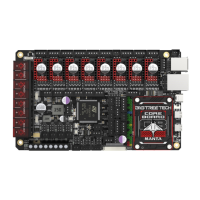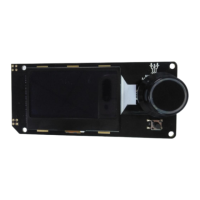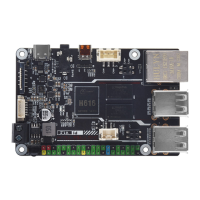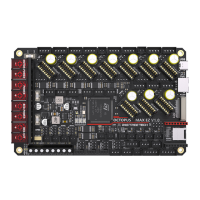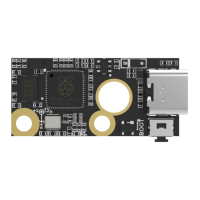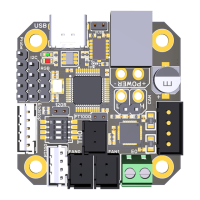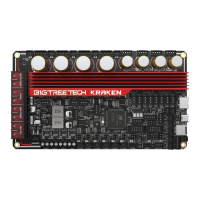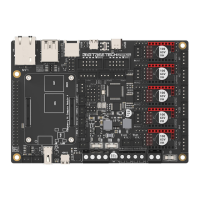
Do you have a question about the BIGTREETECH MANTA M5P V1.0 and is the answer not in the manual?
| Processor | ARM Cortex-M7 |
|---|---|
| Processor Frequency | 480 MHz |
| Clock Speed | 480 MHz |
| Logic Voltage | 3.3V |
| Max Current | 15A |
| RAM | 564KB |
| Communication | USB, CAN, Ethernet |
| CAN Bus Interface | Yes |
| SD Card | Yes |
| GPIO Pins | Multiple |
| MCU Core | 32-bit |
| Input Voltage | 12V/24V DC |
| Heating Bed Output | 1 Channel |
| Heated Rod Output | 2 Channels |
| Firmware | Klipper |
| Motor Driver | Supports TMC2209, TMC5160, TMC2225, etc. |
| Display | LCD12864 |
| PC Communication Interface | USB |
| Ethernet Interface | 10/100M Ethernet |
| Mounting Hole Size | M3 |
Details the 32-bit ARM Cortex-M0+ MCU and thermistor circuit protection against short circuits.
Allows selectable fan voltages (24V, 12V, 5V) to prevent board damage from incorrect voltage.
Supports pull-up resistance setting for PT1000 sensors via jumpers, eliminating extra modules.
Firmware can be upgraded via SD card or DFU using Klipper's make flash command.
Features BTB connectors for flexible core board solutions, including CM4.
Integrated SPI and UART modes for TMC drivers with configurable DIAG pins via jumpers.
Supports filament runout sensors, BLTouch, RGB, and replaceable fuses for easy maintenance.
Onboard proximity switch port and SPI for acceleration sensors, plus new E-FUSE protection.
Covers dimensions, MCU, input voltages, logic voltage, and current ratings.
Details heater connections, fan ports, expansion ports, and motor driver modes.
Specifies motor driver channels, thermistor types, and PT1000 compatibility.
Lists supported display types and PC connection interface (Type-C).
Details compatible printer kinematics and recommended slicing/console software.
Illustrates the physical layout and connection points of all peripheral ports on the motherboard.
Details the specific pin assignments for each connector and port on the motherboard.
Explains powering the board via USB and the status indicator LED (D22).
Details STEP/DIR mode for stepper drivers and jumper settings for microstepping.
Explains jumper settings for TMC drivers in UART mode, including microstep and current configuration.
Explains jumper settings for TMC drivers in SPI mode, including microstep and current configuration.
Details jumper settings for enabling sensorless homing via the DIAG pin on TMC drivers.
Illustrates how to select the voltage for the stepper motor drivers.
Provides visual guidance on connecting the Raspberry Pi CM4 core board to the Manta M5P motherboard.
Details how to configure thermistor inputs for 100K NTC or PT1000 sensors using jumpers and resistors.
Shows the wiring diagram for connecting a BLTouch sensor to the motherboard.
Illustrates the connection of BTT TFT LCD screens to the EXP1 and EXP2 headers.
Provides wiring instructions for connecting RGB LEDs to the motherboard.
Shows how to wire a filament runout sensor to the motherboard.
Details the pinout and functions of the 40-pin GPIO header, including power and specific GPIO pins.
Explains the wiring for DSI/CSI interfaces, likely for displays or cameras.
Demonstrates wiring for NPN proximity switches to the motherboard, including voltage selection.
Guides on downloading OS images (Fluidd, Mainsail, Raspberry Pi OS) for CM4.
Instructions for downloading and installing the official Raspberry Pi Imager tool.
Step-by-step guide on writing the OS image to a MicroSD card using Raspberry Pi Imager for CM4 Lite.
Instructions to enable the CM4's USB 2.0 Hub by modifying the config.txt file.
Guides on installing the DSI1 driver for display output and switching back to HDMI.
Information on installing the CSI1 driver, which is included with the DSI1 driver.
Guides on downloading the specific OS image provided by BIGTREETECH for the CB1.
Instructions for installing Raspberry Pi Imager, also usable for writing CB1 OS images.
Guides on installing Mobaxterm, connecting via SSH, and finding the device's IP address.
Instructions to update firmware by renaming and copying 'klipper.bin' to the SD card.
Guides on updating firmware using the DFU (Device Firmware Update) method via USB.
